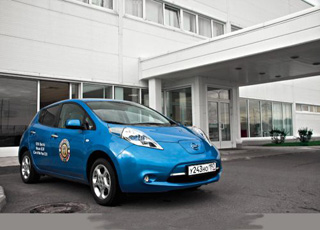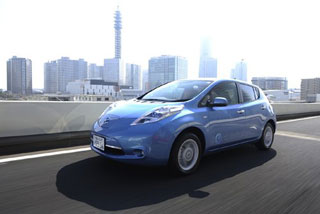Test Drive Nissan Leaf since 2010 Hatchback
Nissan Leaf Electric Chair Test Drive. Wonderful imperceptible in the best sense
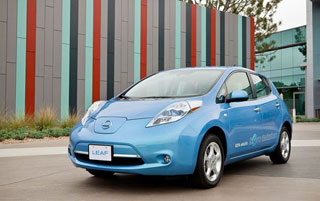 Techinari and fans of science fiction (including your faithful servant), more often than others who induce the dreams of flying cars and other wonders of technical thought, are not really the bulk of buyers of new cars. Recent hot debates that have broken around Chevrolet Volt have shown that most consumers are interested in how electric vehicles are comparable to conventional gasoline cars that they already possess. Because, if it seems, the purchase of an electric vehicle requires some adjustments to the usual way of life: recharging, distance calculation of the distance and special service. For 100 years of experience, the automotive industry is accustomed to gasoline engines, and therefore electric motors are, in some way, deviation from the norm.
Techinari and fans of science fiction (including your faithful servant), more often than others who induce the dreams of flying cars and other wonders of technical thought, are not really the bulk of buyers of new cars. Recent hot debates that have broken around Chevrolet Volt have shown that most consumers are interested in how electric vehicles are comparable to conventional gasoline cars that they already possess. Because, if it seems, the purchase of an electric vehicle requires some adjustments to the usual way of life: recharging, distance calculation of the distance and special service. For 100 years of experience, the automotive industry is accustomed to gasoline engines, and therefore electric motors are, in some way, deviation from the norm. In fact, everything is not the case, and this is the brightest feature of Nissan Leaf, no one calls a car of the future. And although it is hardly like a praise diffilament, in fact it is the best praise, which the car can be given. Nissan could build a car that would look like a starship from the epic wars, and it would have bought a five or ten person. Instead, they made a car, which differs from the main mass, but which at the same time does not scare potential buyers with their fringe design. The concept of the model was not like the car's usual to us, but the production model is surprisingly an ordinary look.
So that we understand what you are talking about, Nissan invited us to drive on this car by cities and calams in the vicinity of Franklin, Tennessee, where the head office of the Representative Office is located. And this is a full test. No more well, ride until the end of the quarter. We have at our disposal of Nissan Leaf on a selling complete set with a fully charged battery and manual after two trial circles along the test polygon. We have a 100-km journey through the central part of the state. Time to find out what is capable of Nissan Leaf on the real road
I'm afraid to repeat, but I will still say Leaf turned out to be quite ordinary. After 10 minutes of driving, the car behaves completely fine, like any hatchback with a four-cylinder gasoline engine under the hood. Surprises another lack of trainee curve. Undoubtedly, it takes some time to get used to the increased sensitivity of the pedal of regenerative brakes, as well as the perfectly smooth acceleration, which is not to meet in any gasoline car, except, except, Rolls-Royce. But these aspects get used to very quickly. You are not required to pass special courses or changes in driving techniques: you just manage this car, like any other.
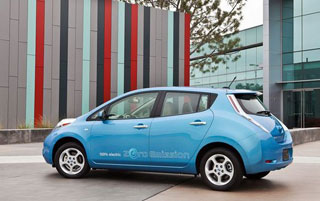 To demonstrate this, Nissan sent us on a special route by imitating the usual day of any Ivan Petrovich Sidorov: a trip to the gym, shopping and school for the child. To start the engine, you just need to click on the Start button. The fact that LEAF works and is ready to go, signals a special bell. To select Drive mode, you need to move similar to the computer mouse to the left and down. All went away. The scale of the sensor next to the speedometer reminds you of how much you click on the accelerator pedal. If you are careful with the pedal, small trees appear on the sensor. Other sensors below show the battery charge level, the remaining stroke reserve and the energy graph consumed by the motor and regenerable. This is somewhat unusual, but there is nothing strange in this.
To demonstrate this, Nissan sent us on a special route by imitating the usual day of any Ivan Petrovich Sidorov: a trip to the gym, shopping and school for the child. To start the engine, you just need to click on the Start button. The fact that LEAF works and is ready to go, signals a special bell. To select Drive mode, you need to move similar to the computer mouse to the left and down. All went away. The scale of the sensor next to the speedometer reminds you of how much you click on the accelerator pedal. If you are careful with the pedal, small trees appear on the sensor. Other sensors below show the battery charge level, the remaining stroke reserve and the energy graph consumed by the motor and regenerable. This is somewhat unusual, but there is nothing strange in this. The remaining reserve of the stroke is undoubtedly many will keep in a state of some tension. Typically, the stroke reserve is determined by the capacity of the car's fuel tank, and this problem is solved by the possibility of fast refueling, so that, in fact, it does not exist. Against this background, Leaf, requiring a lot of time to fully charge the battery, causes reasonable concerns. What does Nissan declare about this? That, in accordance with the data of a sociological survey conducted in the United States, 90% of Americans pass less than 160 km per day, and so coincided that it is precisely so much the recommended movement range for LEAF. In accordance with the received data, about 72% of us pass the day less than 80 km, and 26% of only about 20 km. In other words, the reserve of the LEAF stroke is not a problem if you do not plan long movements from one end of the country to another.
But Nissan has not only statistical calculations, they have answers. The button on the steering wheel activates the display of the standard navigation system, showing two concentric circles relative to your location. Safe stroke stock, absolute stroke. If you specify the destination outside these circles, Nissan Leaf will report the impossibility of action, but at the same time it will lead to the monitor all the nearest refueling stations. Since the number of such filling stations increases (according to Nissan estimates, by 2012 their number will be 12,000), data on new stations will be loaded into the computer through the satellite, and Leaf will be able to make a long-lasting route taking into account the distances between them. He can even tell you how much time you need to spend at each station recharging depending on its power.
 It would be very valuable information if we took advantage of it. Nissan provided us with a booklet indicating destinations for the trip to the data from which we were oriented. And we, of course, were worn. The problem was not that Nissan indicated the wrong directions, and in the fact that we were amazed at how common this car was, and too often distracted by looking at the warnings that appeared on the monitor, like attention: to the right of the refueling station do not stop, and therefore missed some important turns. As a result, our 80 km planned stretched to 104 km. Nissan specialists tried to make a test trip as usual as possible, but it is not so easy when inside journalists.
It would be very valuable information if we took advantage of it. Nissan provided us with a booklet indicating destinations for the trip to the data from which we were oriented. And we, of course, were worn. The problem was not that Nissan indicated the wrong directions, and in the fact that we were amazed at how common this car was, and too often distracted by looking at the warnings that appeared on the monitor, like attention: to the right of the refueling station do not stop, and therefore missed some important turns. As a result, our 80 km planned stretched to 104 km. Nissan specialists tried to make a test trip as usual as possible, but it is not so easy when inside journalists. Wandering around the surroundings in search of the right route, we realized the need to spend some tests dictated by our responsibility as journalists. At first we went to Leaf, as on any other car. No tricks to achieve minimal consumption and other tricks. The measurement with an ordinary stopwatch at the clock showed that until hundreds of the machine accelerates in 10 seconds, approximately the same time spent the Toyota Prius. Despite the fact that the maximum speed of the LEAF declared by Nissan is 145 km / h, we broke it up to 153 km / h. We do not recommend ride at such a speed, as it sharply reduces the reserve of the stroke. Speaking of the latter, by the way, it is worth noting that after the day of the real roads for the real roads, Leaf had 122 km, although Nissan declares about 130-160 km.
In the most difficult conditions, let's say, in the center of New York at the rush hour in the middle of the winter, this indicator should fall up to 95 km. But this is enough to cross the Manhattan from the edge to the edge 4 times. Nissan assures that hot weather does not affect the stock of their electric vehicle, and as evidence provides an example of tests in Taksone in July, during which LEAF was able to drive at one charge 136 km. Particularly lean drivers will undoubtedly drive all 160 km using the ECO mode, which mitches the accelerator pedal and increases the regeneration of the brake system, which allows for an average of 16 km away.
When the battery charge on the outcome, Leaf informs that it is impossible not to notice. In our case, when the stroke reserves dropped to 25 km, two signal lights tanned on the panel, a warning message appeared on the monitor, and a sound message sounded about the need for emergency recharging. The battery charge indicator also begins to flash, so it is impossible not to notice. Before upset, we thought a little and realized that 25 km was much more than the road to the nearest shopping center.
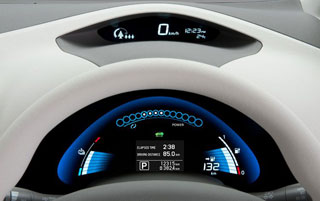 As in the case of any other electric car, the time of complete charge of the LEAF battery varies very much depending on which the power source is connected. Remove the portable charging cord from a special case in the trunk of the machine and stick it into the nearest socket. The full charge time will be 20 hours. When using a special 220-volt charger, it is reduced to 8 hours. For long-range travel, this is also not the best option, so Nissan makes the main rate on the coming appearance of quick charging (Quick Charge), connected to commercial 440-volt stations, where Leaf will be able to get 80% of charge in just 30 minutes while you are in the restroom Or buy anything in a vending machine. It is not recommended to use the services of such items more than 2 times a day, as this may damage the battery, so that the effective reserve of the course is still 320 km if you intend to overcome such a distance per day.
As in the case of any other electric car, the time of complete charge of the LEAF battery varies very much depending on which the power source is connected. Remove the portable charging cord from a special case in the trunk of the machine and stick it into the nearest socket. The full charge time will be 20 hours. When using a special 220-volt charger, it is reduced to 8 hours. For long-range travel, this is also not the best option, so Nissan makes the main rate on the coming appearance of quick charging (Quick Charge), connected to commercial 440-volt stations, where Leaf will be able to get 80% of charge in just 30 minutes while you are in the restroom Or buy anything in a vending machine. It is not recommended to use the services of such items more than 2 times a day, as this may damage the battery, so that the effective reserve of the course is still 320 km if you intend to overcome such a distance per day. All these arguments about the turn of the progress inevitably lead to another hot question: how will the charging of this car be charged? It depends on the tariffs of the energy company, the services of which you use, although you are able to calculate everything yourself. Maximum battery capacity of LEAF 24 kW-hours, but you hardly manage to completely discharge it. Nissan takes the average cost of 11 cents per kWh-hour, which gives us $ 2.64 for one complete charge. Here, in Los Angeles, the cost of kW-hours varies from 4.6 to 16 cents, depending on how much electricity you consume, what is your service plan, and at what time of year and day you charge your electric vehicle. Thus, the cost of one complete charge will vary from $ 1.1 to $ 3.84. Can you pour a full gasoline tank for such an amount? Currently, public charging stations are mostly free to popularize the use of electric vehicles and attract buyers to nearby shops. In the future, they will most likely become paid, and yet it will be much cheaper than refueling with gasoline. Nissan even takes the courage to argue that Leaf will remain competitive, even if the price of gasoline decreases to $ 1.1 per gallon (3.78 l). And it is hardly ever happening.
But it is only the cost of recharging your electric vehicle. There is also a single-time cost of $ 2,2, which you have to lay out for the installation in your garage of a 220-volt charger, although, on the other hand, there is an excellent news. No need for maintenance. Nissan LEAF requires only an annual battery status check, so you can forget about the replacement of the oil in the engine every three months, about drive belts, antifreeze, etc. Dealer service centers with this situation will soon become deserted, and it is difficult for me to even submit a dealer who receives most of the profits from the service of sold cars, which would look forward to the onset of such a future.
In general, the Nissan Leaf management is much easier than all these economic calculations and calculations. The steering wheel is light and fast, and therefore the machine seems easy, like a feather. The 272-kg battery installed under the floor of the cabin provides a very low center of gravity and a magnificent mass distribution along the axes, so that the controllability of the LEAF does not cause any complaints. Tires with low rolling resistance, which is not surprising, prone to drift, in particular, the car easily demonstrates insufficient turning, but it is very easy to control it. The front lever suspension type Macpherson and the rear multi-dimensional is simple and understandable, but with all its simplicity, they provide a very smooth move and minimal rolls even when performing emergency maneuvers.
Inside the car is also quite ordinary. The design of the front panel and futuristic devices is exactly enough so as not to attract unnecessary attention and not to require a compromise in terms of ergonomics. Sitting comfortable, the interior accommodates five adults, if you breathe a little. The spaces above the head in the front of the cabin are tremendous, and behind the passengers with growth below 195 cm will feel quite comfortable. The rear seat is located just above in relation to the front, since it is right above the battery, although it is barely noticeable. The space of the cabin is organized well, inside much more spacious than it may seem if you look at the car outside. LEAF noise insulation is good, the noise level in the cabin when driving along the highway is not higher than in some ordinary sedan, and maybe even a little less. With the exception of the steering wheel, all the materials used in the cabin (or from the recycling, or with the prospect of them to become after the machine utilization) look quite nice, the quality of the finish is just fantastic. We also noted that all devices are slightly rejected from the driver, and those who are far from the steering wheel, without telescopic adjustment, may encounter the problem of overview of the entire dashboard.
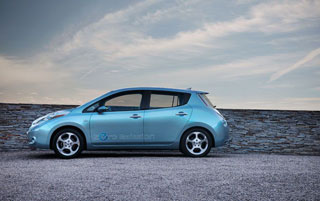 If LEAF is a stumbling block, then this is the capacity of its luggage compartment. It does not have spars, only a compressor and a pair of patches for tire repair, which means that the floor level at the car is very low. It is excellent if you need to carry a lot of big suitcases in the trunk. It is bad that you have to first raise the suitcases by 20 cm to pull them out from there. Despite the fact that the backs of the rear seats are folded, they do not form with a half of the smooth surface. They form a line with a battery located right behind them, which is 20 cm above the floor line. As a result, you get a trunk with a large volume, but very strange form. It is rather a wide passage than a spacious luggage compartment. But you are unlikely to have to carry large-sized furniture with your Nissan Leaf.
If LEAF is a stumbling block, then this is the capacity of its luggage compartment. It does not have spars, only a compressor and a pair of patches for tire repair, which means that the floor level at the car is very low. It is excellent if you need to carry a lot of big suitcases in the trunk. It is bad that you have to first raise the suitcases by 20 cm to pull them out from there. Despite the fact that the backs of the rear seats are folded, they do not form with a half of the smooth surface. They form a line with a battery located right behind them, which is 20 cm above the floor line. As a result, you get a trunk with a large volume, but very strange form. It is rather a wide passage than a spacious luggage compartment. But you are unlikely to have to carry large-sized furniture with your Nissan Leaf. Nowadays, when everyone is trying to save, one of the decisive factors when buying a new car is its cost. The fact that the price of Nissan Leaf begins with a mark of $ 32,780, it will be quite reasonable from the potential buyer to wonder why not buy, for example, Audi A3. Of course, if you prefer the SL package instead of SV, offering a rear view chamber and a solar panel recharged a 12-volt battery, you will have to pay another $ 940. In the future, Nissan will equip the LEAF heated seats and the steering wheel, which will spend less energy than a conventional cabin heater. But we have tax breaks. Buy Leaf today for the full price, and next year Uncle Sam will return to you for this $ 7,500, which reduces the cost of Leaf up to $ 25 280. If you live in the Hawaiian Islands, the staff will return to you another $ 4,500, and the price will drop to $ 20,0780. California, Colorado and Georgia will be returned to their resident who bought Nissan Leaf, as much as $ 5,000, and therefore, here this machine will cost $ 20 280. Other states also provide similar benefits. True, no one compensates for you the $ 2 200 that you spend on the installation of the charger, so just add it to the total cost of the car.
20,280 dollars for a new car is a good price for any car. Leaf has a navigation system, headlights with LEDs, the ability to connect your communicator to remotely turn on charging, air conditioning or heater, plus, this is a production model on a fantastically low price. Will Nissan be able to maintain the popularity of this model after the financial support from the state runs out? Nissan hopes that by that time, prices for cars will decline, and consumers will be advocating electric vehicles. Will it really really? If all electromotives are as good as Nissan Leaf, I would not put on the opposite.
A source: Motor Trend.










